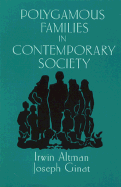Book contents
- Frontmatter
- Contents
- Foreword
- Preface and acknowledgments
- 1 Introduction
- Historical background
- Early stages of relationships
- 5 Deciding to add a new wife to a family
- 6 Courtship
- 7 Wedding and marriage ceremonies
- 8 Honeymoons
- 9 Adjusting to a new plural marriage
- Home environments of plural families
- Managing everyday life
- Social-emotional and family relationships
- Appendix A Methodology and procedure
- Appendix B Demographics of Mormon polygyny
- Notes
- References
- Index
7 - Wedding and marriage ceremonies
Published online by Cambridge University Press: 05 May 2010
- Frontmatter
- Contents
- Foreword
- Preface and acknowledgments
- 1 Introduction
- Historical background
- Early stages of relationships
- 5 Deciding to add a new wife to a family
- 6 Courtship
- 7 Wedding and marriage ceremonies
- 8 Honeymoons
- 9 Adjusting to a new plural marriage
- Home environments of plural families
- Managing everyday life
- Social-emotional and family relationships
- Appendix A Methodology and procedure
- Appendix B Demographics of Mormon polygyny
- Notes
- References
- Index
Summary
Wedding ceremonies signify the end of courtship or other premarital events and the formal beginning of a husband–wife relationship. Weddings may consist of a series of activities, including the bride and groom's arrival at a ceremonial site, vows and rituals, gift exchanges, feasts and celebrations, and immediate postnuptial events. Couple members, families, friends, and community members often participate in weddings, playing roles in accordance with cultural practices.
Weddings of present-day Mormon fundamentalists vary with regard to where ceremonies are held, who officiates, who attends, what participants wear, and what role established wives play. At the same time, fundamentalists weddings follow the general format of Western Christian marriage ceremonies. The bride and groom appear before an official of the church, prayers and pronouncements are made regarding the religious basis and importance of marriage, the bride and groom are told of their responsibilities to one another and to their religious values, and the couple exchange vows of love and loyalty. Although a fundamentalist wedding formalizes the dyadic bond between a man and a woman, established wives often participate in the marriage ceremony, thereby also symbolizing the communal nature of weddings and plural family life.
We first describe wedding and marriage ceremonies in a sample of world cultures, to illustrate the variety of ways in which the event is observed. We then turn to the dyadic and communal aspects of marriage ceremonies and the location, management, participants, and tensions and stresses of fundamentalist weddings.
- Type
- Chapter
- Information
- Polygamous Families in Contemporary Society , pp. 126 - 142Publisher: Cambridge University PressPrint publication year: 1996

